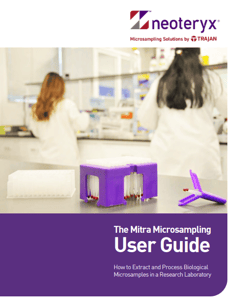microsampling for infectious disease studies
A few drops of blood from a finger-stick microsample provide scientists with sufficient information to study antigens, antibodies that may support immune response, cytokines, and the efficacy of mRNA vaccines against a range of infectious diseases.
Using Blood Microsamples to Study Disease
Preventing the next pandemic requires a deeper understanding of disease pathogens and processes. Access to remote populations and high-quality blood samples are critical to helping scientists generate reliable data that deliver deeper insights. The Mitra® device based on VAMS® technology and the hemaPEN®, a next generation DBS device, have been used by remote study participants to collect blood samples for research on SARS-CoV-2, influenza, respiratory syncytial virus (RSV) and other infectious diseases.
Explore our resources below that support advancements in infectious disease and population health studies...
Frequently Asked Questions (FAQs)
Mitra® devices based on VAMS® technology and hemaPEN® devices have been used in serology studies of infectious diseases including SARS-CoV-2 and Influenza, among others. During the COVID-19 Pandemic, remote microsampling devices have been deployed to study populations across many geographical areas. Thousands of people have used our devices to collect blood samples at home for bioanalysis in labs at the National Institutes of Health (NIH), LGC Group, Stanford University, Harvard, University of Rochester, and other organizations globally to help increase the science community's understanding of antibodies and immunity against viral pathogens.
Since the beginning of the COVID-19 Pandemic, researchers from many organizations have published articles on successful serology studies of SARS-CoV-2 using microsampling devices.
Research provided in our Technical Resource Library illustrates:
- > 99% Mitra sampling success rate in studies with thousands of remote participants
- Assays compatible with Mitra samples with 100% sensitivity and 100% specificity with high confidence intervals
- Ability to detect IgG, IgM, IgA and neutralizing antibodies from dried blood microsamples
- Immunoassay methodology for Roche Elecsys®, Luminex, Quanterix Simoa®, and more
Access our Resource Library for these details plus insight into cytokines and a multiplex assay that uses microsampling to simultaneously measure >30 strains of influenza.
Many analytes can be extracted using volumetric microsampling, and are compatible with hemaPEN® and Mitra® devices with VAMS® technology. Some of the literature and resources on our website discuss different analytes that have been extracted with our microsampling devices. Type your analyte of interest in our Technical Resource Library search field to find the information you seek.
Sample success rates are high for Mitra® and hemaPEN® devices, which are based on volumetric microsampling. The absorptive VAMS® tips on Mitra can absorb homogenous samples with 99% acceptance rates. By following the illustrated instructions and demo videos available with hemaPEN and Mitra, non-professional users can reliably collect fixed volume samples that are precise enough for lab analysis.
These volumetric microsampling devices overcome the hematocrit (HCT) bias that may occur with DBS cards, where non-homogenous blood spots on filter paper have higher variability and higher failure rates.
Published research papers show that dried capillary whole blood microsamples collected in 10, 20, or 30 µL volumes are enough for good extraction and analysis. These samples also yield high-quality data that are similar to data from venous blood. Studies have shown very high correlations of Mitra samples to plasma/serum samples nucleocapsid (R2 = 0.9957), RBD (R2 = 0.9929), & spike (R2 = 0.9918) proteins.
The literature provides case examples of microsampling in research applications. Visit the Technical Resource Library to review many comparative studies that describe what others have achieved with microsampling in their research.
The process of transitioning to microsampling takes about 6-8 months and is divided into three phases, with ongoing technical support from the Neoteryx Microsampling Team:
- Education: [1 - 2 weeks] The introductory phase
- Evaluation: [4 - 6 weeks] Extraction, linearity & signal-to-noise studies
- Validation: [6 - 8 months] Validating your method
See our Microsampling User Guide for details.
 Microsampling User Guide
Microsampling User Guide
This technical user guide is designed to get you started with microsampling. The printed guidance from our technical director helps you make initial decisions on best practices for achieving solid analytical validations in your research projects. What microsample volume is needed for your assay? What analyte classes are compatible with microsampling? How do you process microsamples in the lab? Download the guide to find answers to these questions, and more!
Infectious Disease Blogs
Our website features many blogs about infectious disease studies that leverage remote microsampling to enable people to participate in science while staying safe at home. Click the button below to explore all of our infectious disease blogs, gathered together in a single, curated list.
Podcast on an NIH Study
In this podcast, research scientist Kaitlyn Sadtler, PhD, at the National Institute of Biomedical Imaging and Bioengineering (NIBIB), part of the National Institutes of Health (NIH) discusses the first serology study of the novel coronavirus known as SARS-CoV-2. NIH researchers used remotely collected blood microsamples to help identify undetected cases of COVID-19 illness.
Gain Access to the Microsampling Resource Library!
How do research scientists use microsampling to study infectious disease, immune response and vaccine efficacy? Fill in the form to gain access to our Microsampling Resource Library where you can search articles, presentations and case studies published by your peers.


